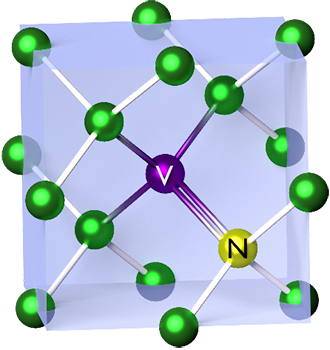Summary
The nitrogen-vacancy (NV) center in diamond has emerged in the last decade as the most exciting new technology for nanoscale magnetic measurements. By controlling and interrogating the quantum spin state of this crystal defect, researchers have been able to demonstrate field detectivity down to nT/Hz1/2 on length scales of a few tens of nanometers. In air. At room temperature. These capabilities have inspired proof-of-concept measurements in fields as diverse as cell biology, microwave engineering, and solid-state physics. Here, the goals of this project are twofold: to build up a world-class facility for measurements of magnetic nanodevices, and to reduce barriers to application through improved measurement methods.
Description

Nitrogen-vacancy center in a diamond crystal
A flaw in a crystal might not be an intuitive choice for a measurement tool, but the nitrogen-vacancy (NV-) defect in diamond is something special. Using light, we prepare the NV- center’s the quantum spin state, it interacts with magnetic fields, and we read out the resulting spin state through counting emitted photons. In addition to these experimental handles, the NV- spin state is especially long-lived; in carefully prepared diamond it can remain coherent up to milliseconds at room temperature.
The long coherence time of the spin state in NV- centers allows sensitive magnetometry. In a millisecond, the magnetic resonance frequency of the spin can be determined with kilohertz precision, ultimately resulting in field detectivities on the order of 1 nT/Hz1/2. For scale, 1 nT is approximately the field generated 50 nm from a single electron’s magnetic moment.
The NV center also offers spatial resolution. When the sample is outside the diamond, the important length is the distance to the sample. Naturally stable centers are found at depths greater than about 20 nm, but for greater resolution and sensitivity, stabilization of NV centers near diamond surfaces is an active area of research in the field.
Sub-Projects
Magnetic Nanodevices
In the confined geometry of a nanostructure, magnetic excitations (spin waves, magnons, modes) oscillate at discrete frequencies, typically in the frequency range of a few GHz. In thermal equilibrium these modes generate field noise, which accelerates relaxation of the NV- spin state. The increase in relaxation rate is proportional to the spectral density of the field noise at the NV- transition frequency.

Measurement Methods
One way to improve measurements is to change the readout physics. We are working toward improved readout efficiency by learning to manipulate and control the charge state of NV- centers. In conventional methods an individual NV- center will emit only 1 or 2 photons before the spin is reset, and only a small fraction of those emitted photons will be captured and detected. So, a good measurement will require many repeats of each experimental run. To reduce this demand, we implement newly-developed spin-charge conversion methods. Spin-dependent ionization (NV- → NV0 + e-) of the NV center allows the spin state to be imprinted on the charge state, which is then quickly determined by a faster, many-photon measurement.
In addition to improving readout, we also advance experimental design and data analysis to glean maximum benefit from the few photons that are collected. The common lock-in amplifier would be the go-to laboratory tool for detecting weak signals, but the raw signal of an NV- measurement is a series of randomly-timed “clicks” of a photon detector, which is incompatible with lock-in amplifiers. To help bridge this difference, we have invented a phase-sensitive differential rate meter that does the job of a lock-in, detecting small differences in count rates and facilitating, e.g. frequency-modulated measurements for field tracking.
In a related project, we develop optimal Bayesian experimental design methods to avoid spending time on low-utility runs, using real-time analysis to choose effective experimental settings.

